MGT302 Strategic Management: A Strategic Analysis of Woolworths
VerifiedAdded on 2023/06/08
|10
|2941
|165
Case Study
AI Summary
This case study provides a strategic analysis of Woolworths, a leading supermarket company in the Australian market. The analysis includes a macro-environmental assessment using PESTLE, an industry analysis using Porter's Five Forces, and a company analysis focusing on resources, capabilities, core competencies, and VRIO framework. The report identifies key challenges faced by Woolworths, such as increasing competition and the rise of e-commerce, and analyzes its competitive position against rivals like Coles, Aldi, and Amazon. The study concludes that Woolworths employs a cost leadership strategy and highlights the importance of innovation, supply chain management, and brand positioning for maintaining a competitive edge. This document is available on Desklib, where students can find a wide range of solved assignments and study resources.
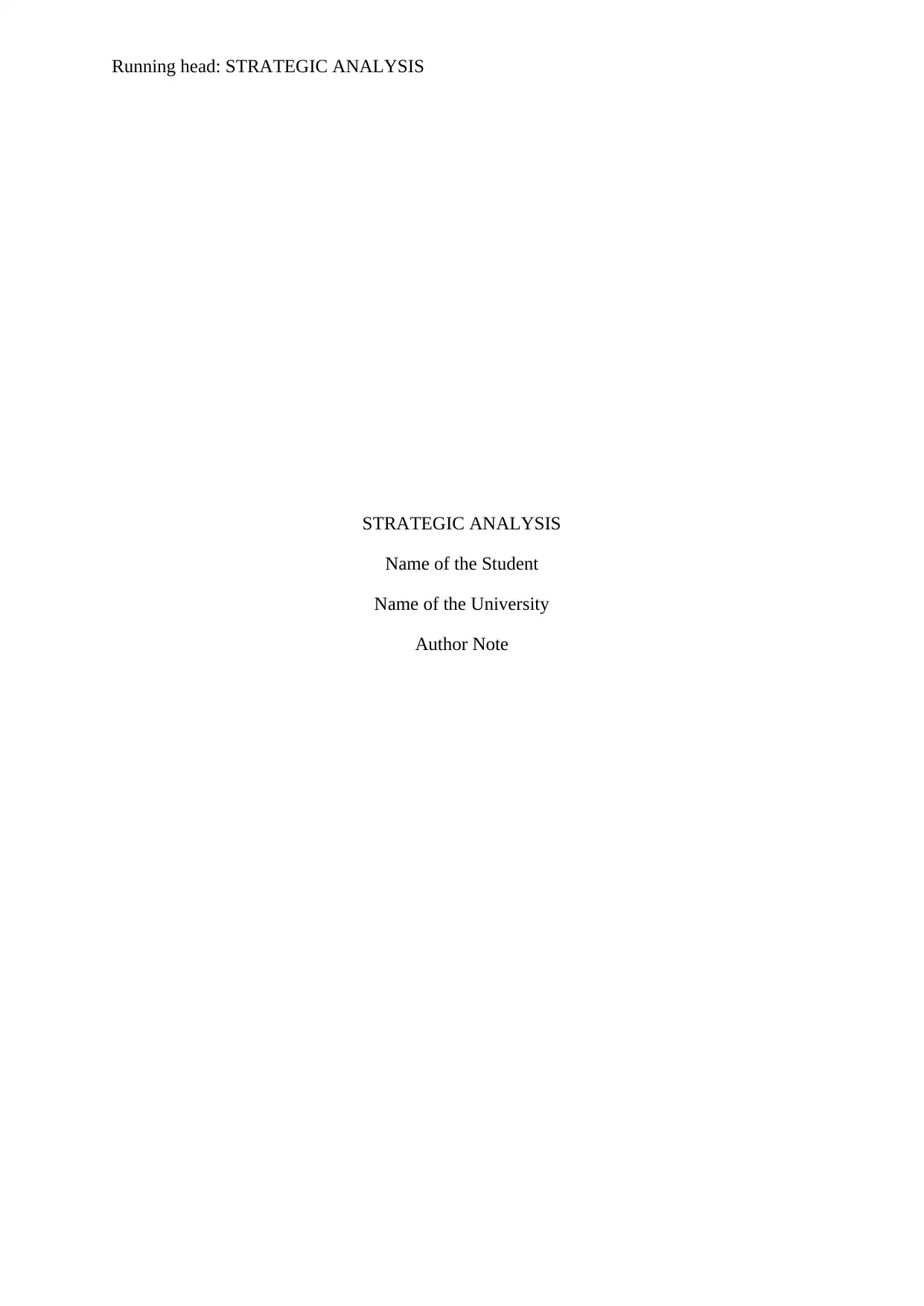
Running head: STRATEGIC ANALYSIS
STRATEGIC ANALYSIS
Name of the Student
Name of the University
Author Note
STRATEGIC ANALYSIS
Name of the Student
Name of the University
Author Note
Paraphrase This Document
Need a fresh take? Get an instant paraphrase of this document with our AI Paraphraser

1STRATEGIC ANALYSIS
Executive Summary
Strategies form an integral part of the organization. Any company functioning without a
strategy will not be able to survive for a long period of time. Hence, in order to form a proper
strategy, the organizations are required to undertake a comprehensive strategic analysis like
External market analysis, industry analysis, competitor analysis and company analysis. The
company chosen for this report is Woolworths Supermarkets in the Australian Supermarket
Industry. The given report will be identifying the macro as well as micro environment,
analysing internal competencies and also use this as a basis of to provide recommendations
for the same.
Executive Summary
Strategies form an integral part of the organization. Any company functioning without a
strategy will not be able to survive for a long period of time. Hence, in order to form a proper
strategy, the organizations are required to undertake a comprehensive strategic analysis like
External market analysis, industry analysis, competitor analysis and company analysis. The
company chosen for this report is Woolworths Supermarkets in the Australian Supermarket
Industry. The given report will be identifying the macro as well as micro environment,
analysing internal competencies and also use this as a basis of to provide recommendations
for the same.
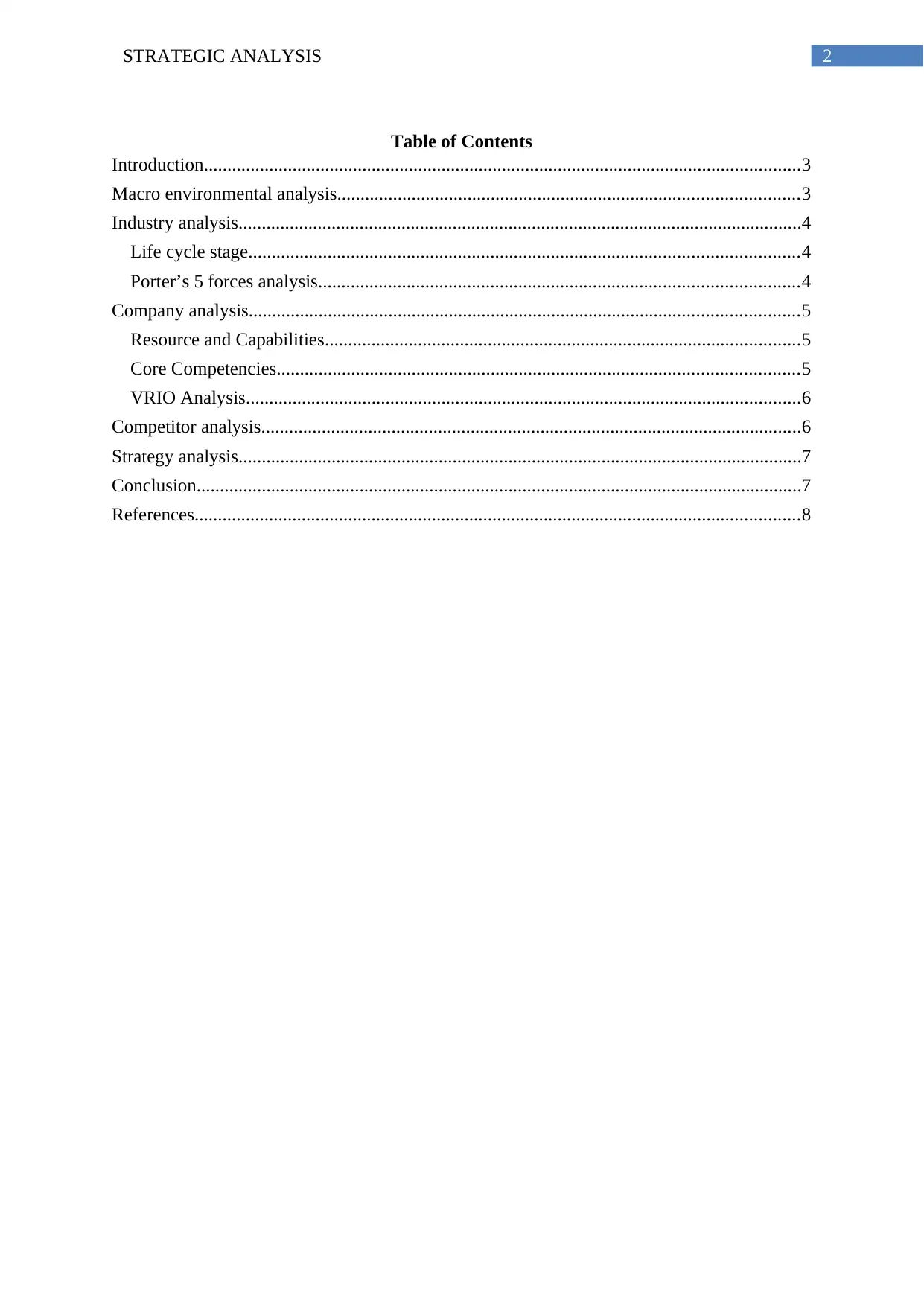
2STRATEGIC ANALYSIS
Table of Contents
Introduction................................................................................................................................3
Macro environmental analysis...................................................................................................3
Industry analysis.........................................................................................................................4
Life cycle stage......................................................................................................................4
Porter’s 5 forces analysis.......................................................................................................4
Company analysis......................................................................................................................5
Resource and Capabilities......................................................................................................5
Core Competencies................................................................................................................5
VRIO Analysis.......................................................................................................................6
Competitor analysis....................................................................................................................6
Strategy analysis.........................................................................................................................7
Conclusion..................................................................................................................................7
References..................................................................................................................................8
Table of Contents
Introduction................................................................................................................................3
Macro environmental analysis...................................................................................................3
Industry analysis.........................................................................................................................4
Life cycle stage......................................................................................................................4
Porter’s 5 forces analysis.......................................................................................................4
Company analysis......................................................................................................................5
Resource and Capabilities......................................................................................................5
Core Competencies................................................................................................................5
VRIO Analysis.......................................................................................................................6
Competitor analysis....................................................................................................................6
Strategy analysis.........................................................................................................................7
Conclusion..................................................................................................................................7
References..................................................................................................................................8
⊘ This is a preview!⊘
Do you want full access?
Subscribe today to unlock all pages.

Trusted by 1+ million students worldwide
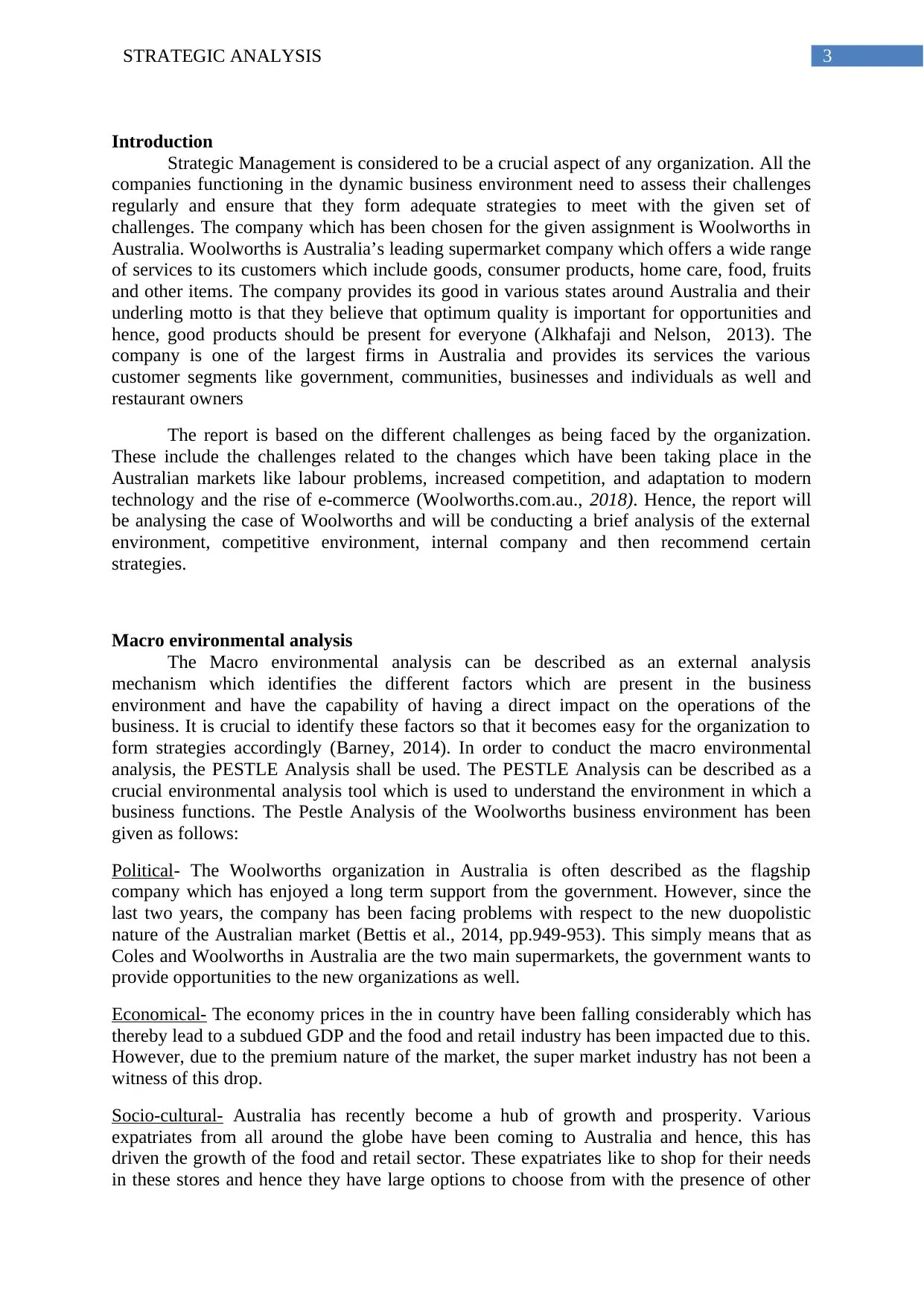
3STRATEGIC ANALYSIS
Introduction
Strategic Management is considered to be a crucial aspect of any organization. All the
companies functioning in the dynamic business environment need to assess their challenges
regularly and ensure that they form adequate strategies to meet with the given set of
challenges. The company which has been chosen for the given assignment is Woolworths in
Australia. Woolworths is Australia’s leading supermarket company which offers a wide range
of services to its customers which include goods, consumer products, home care, food, fruits
and other items. The company provides its good in various states around Australia and their
underling motto is that they believe that optimum quality is important for opportunities and
hence, good products should be present for everyone (Alkhafaji and Nelson, 2013). The
company is one of the largest firms in Australia and provides its services the various
customer segments like government, communities, businesses and individuals as well and
restaurant owners
The report is based on the different challenges as being faced by the organization.
These include the challenges related to the changes which have been taking place in the
Australian markets like labour problems, increased competition, and adaptation to modern
technology and the rise of e-commerce (Woolworths.com.au., 2018). Hence, the report will
be analysing the case of Woolworths and will be conducting a brief analysis of the external
environment, competitive environment, internal company and then recommend certain
strategies.
Macro environmental analysis
The Macro environmental analysis can be described as an external analysis
mechanism which identifies the different factors which are present in the business
environment and have the capability of having a direct impact on the operations of the
business. It is crucial to identify these factors so that it becomes easy for the organization to
form strategies accordingly (Barney, 2014). In order to conduct the macro environmental
analysis, the PESTLE Analysis shall be used. The PESTLE Analysis can be described as a
crucial environmental analysis tool which is used to understand the environment in which a
business functions. The Pestle Analysis of the Woolworths business environment has been
given as follows:
Political- The Woolworths organization in Australia is often described as the flagship
company which has enjoyed a long term support from the government. However, since the
last two years, the company has been facing problems with respect to the new duopolistic
nature of the Australian market (Bettis et al., 2014, pp.949-953). This simply means that as
Coles and Woolworths in Australia are the two main supermarkets, the government wants to
provide opportunities to the new organizations as well.
Economical- The economy prices in the in country have been falling considerably which has
thereby lead to a subdued GDP and the food and retail industry has been impacted due to this.
However, due to the premium nature of the market, the super market industry has not been a
witness of this drop.
Socio-cultural- Australia has recently become a hub of growth and prosperity. Various
expatriates from all around the globe have been coming to Australia and hence, this has
driven the growth of the food and retail sector. These expatriates like to shop for their needs
in these stores and hence they have large options to choose from with the presence of other
Introduction
Strategic Management is considered to be a crucial aspect of any organization. All the
companies functioning in the dynamic business environment need to assess their challenges
regularly and ensure that they form adequate strategies to meet with the given set of
challenges. The company which has been chosen for the given assignment is Woolworths in
Australia. Woolworths is Australia’s leading supermarket company which offers a wide range
of services to its customers which include goods, consumer products, home care, food, fruits
and other items. The company provides its good in various states around Australia and their
underling motto is that they believe that optimum quality is important for opportunities and
hence, good products should be present for everyone (Alkhafaji and Nelson, 2013). The
company is one of the largest firms in Australia and provides its services the various
customer segments like government, communities, businesses and individuals as well and
restaurant owners
The report is based on the different challenges as being faced by the organization.
These include the challenges related to the changes which have been taking place in the
Australian markets like labour problems, increased competition, and adaptation to modern
technology and the rise of e-commerce (Woolworths.com.au., 2018). Hence, the report will
be analysing the case of Woolworths and will be conducting a brief analysis of the external
environment, competitive environment, internal company and then recommend certain
strategies.
Macro environmental analysis
The Macro environmental analysis can be described as an external analysis
mechanism which identifies the different factors which are present in the business
environment and have the capability of having a direct impact on the operations of the
business. It is crucial to identify these factors so that it becomes easy for the organization to
form strategies accordingly (Barney, 2014). In order to conduct the macro environmental
analysis, the PESTLE Analysis shall be used. The PESTLE Analysis can be described as a
crucial environmental analysis tool which is used to understand the environment in which a
business functions. The Pestle Analysis of the Woolworths business environment has been
given as follows:
Political- The Woolworths organization in Australia is often described as the flagship
company which has enjoyed a long term support from the government. However, since the
last two years, the company has been facing problems with respect to the new duopolistic
nature of the Australian market (Bettis et al., 2014, pp.949-953). This simply means that as
Coles and Woolworths in Australia are the two main supermarkets, the government wants to
provide opportunities to the new organizations as well.
Economical- The economy prices in the in country have been falling considerably which has
thereby lead to a subdued GDP and the food and retail industry has been impacted due to this.
However, due to the premium nature of the market, the super market industry has not been a
witness of this drop.
Socio-cultural- Australia has recently become a hub of growth and prosperity. Various
expatriates from all around the globe have been coming to Australia and hence, this has
driven the growth of the food and retail sector. These expatriates like to shop for their needs
in these stores and hence they have large options to choose from with the presence of other
Paraphrase This Document
Need a fresh take? Get an instant paraphrase of this document with our AI Paraphraser
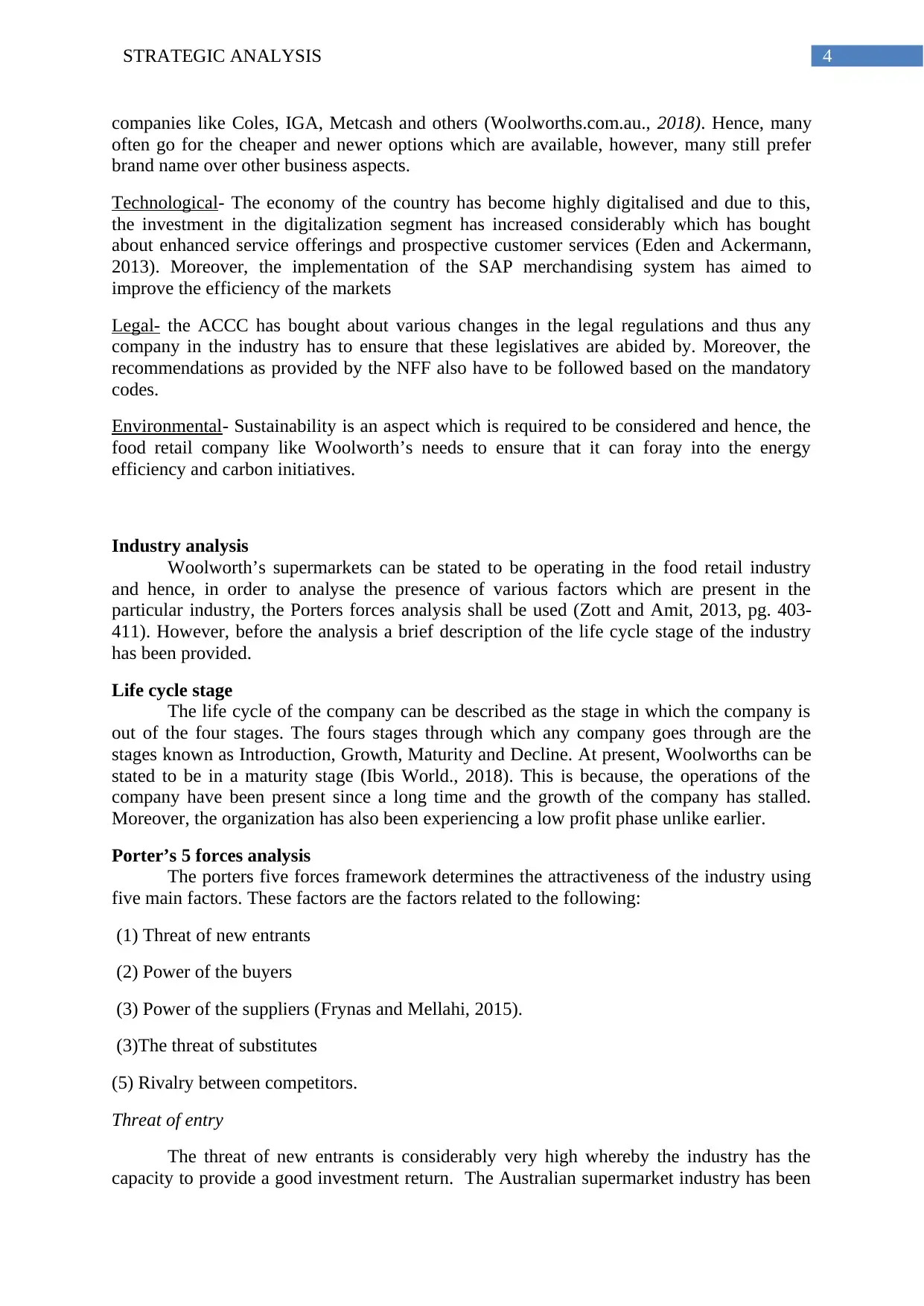
4STRATEGIC ANALYSIS
companies like Coles, IGA, Metcash and others (Woolworths.com.au., 2018). Hence, many
often go for the cheaper and newer options which are available, however, many still prefer
brand name over other business aspects.
Technological- The economy of the country has become highly digitalised and due to this,
the investment in the digitalization segment has increased considerably which has bought
about enhanced service offerings and prospective customer services (Eden and Ackermann,
2013). Moreover, the implementation of the SAP merchandising system has aimed to
improve the efficiency of the markets
Legal- the ACCC has bought about various changes in the legal regulations and thus any
company in the industry has to ensure that these legislatives are abided by. Moreover, the
recommendations as provided by the NFF also have to be followed based on the mandatory
codes.
Environmental- Sustainability is an aspect which is required to be considered and hence, the
food retail company like Woolworth’s needs to ensure that it can foray into the energy
efficiency and carbon initiatives.
Industry analysis
Woolworth’s supermarkets can be stated to be operating in the food retail industry
and hence, in order to analyse the presence of various factors which are present in the
particular industry, the Porters forces analysis shall be used (Zott and Amit, 2013, pg. 403-
411). However, before the analysis a brief description of the life cycle stage of the industry
has been provided.
Life cycle stage
The life cycle of the company can be described as the stage in which the company is
out of the four stages. The fours stages through which any company goes through are the
stages known as Introduction, Growth, Maturity and Decline. At present, Woolworths can be
stated to be in a maturity stage (Ibis World., 2018). This is because, the operations of the
company have been present since a long time and the growth of the company has stalled.
Moreover, the organization has also been experiencing a low profit phase unlike earlier.
Porter’s 5 forces analysis
The porters five forces framework determines the attractiveness of the industry using
five main factors. These factors are the factors related to the following:
(1) Threat of new entrants
(2) Power of the buyers
(3) Power of the suppliers (Frynas and Mellahi, 2015).
(3)The threat of substitutes
(5) Rivalry between competitors.
Threat of entry
The threat of new entrants is considerably very high whereby the industry has the
capacity to provide a good investment return. The Australian supermarket industry has been
companies like Coles, IGA, Metcash and others (Woolworths.com.au., 2018). Hence, many
often go for the cheaper and newer options which are available, however, many still prefer
brand name over other business aspects.
Technological- The economy of the country has become highly digitalised and due to this,
the investment in the digitalization segment has increased considerably which has bought
about enhanced service offerings and prospective customer services (Eden and Ackermann,
2013). Moreover, the implementation of the SAP merchandising system has aimed to
improve the efficiency of the markets
Legal- the ACCC has bought about various changes in the legal regulations and thus any
company in the industry has to ensure that these legislatives are abided by. Moreover, the
recommendations as provided by the NFF also have to be followed based on the mandatory
codes.
Environmental- Sustainability is an aspect which is required to be considered and hence, the
food retail company like Woolworth’s needs to ensure that it can foray into the energy
efficiency and carbon initiatives.
Industry analysis
Woolworth’s supermarkets can be stated to be operating in the food retail industry
and hence, in order to analyse the presence of various factors which are present in the
particular industry, the Porters forces analysis shall be used (Zott and Amit, 2013, pg. 403-
411). However, before the analysis a brief description of the life cycle stage of the industry
has been provided.
Life cycle stage
The life cycle of the company can be described as the stage in which the company is
out of the four stages. The fours stages through which any company goes through are the
stages known as Introduction, Growth, Maturity and Decline. At present, Woolworths can be
stated to be in a maturity stage (Ibis World., 2018). This is because, the operations of the
company have been present since a long time and the growth of the company has stalled.
Moreover, the organization has also been experiencing a low profit phase unlike earlier.
Porter’s 5 forces analysis
The porters five forces framework determines the attractiveness of the industry using
five main factors. These factors are the factors related to the following:
(1) Threat of new entrants
(2) Power of the buyers
(3) Power of the suppliers (Frynas and Mellahi, 2015).
(3)The threat of substitutes
(5) Rivalry between competitors.
Threat of entry
The threat of new entrants is considerably very high whereby the industry has the
capacity to provide a good investment return. The Australian supermarket industry has been
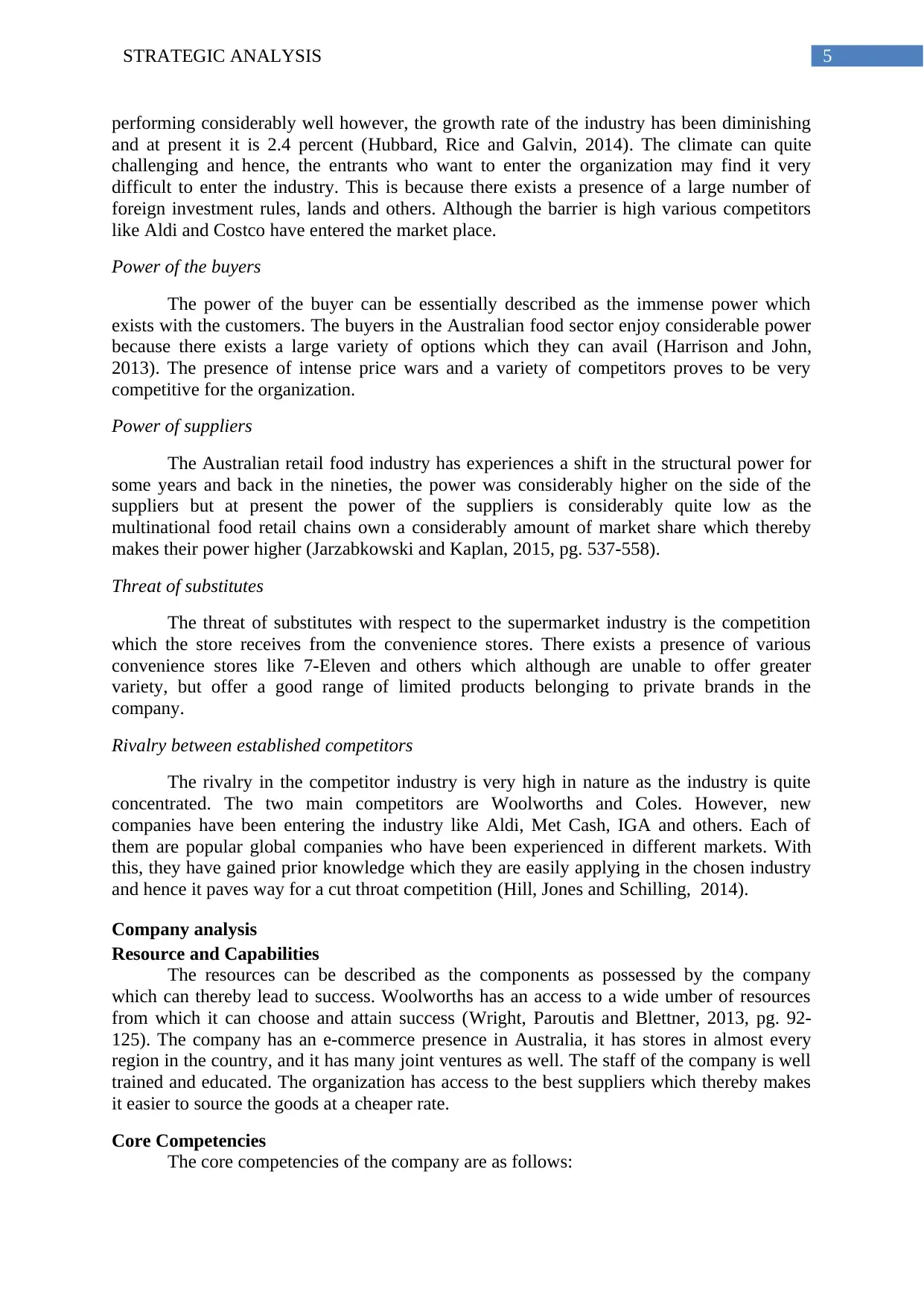
5STRATEGIC ANALYSIS
performing considerably well however, the growth rate of the industry has been diminishing
and at present it is 2.4 percent (Hubbard, Rice and Galvin, 2014). The climate can quite
challenging and hence, the entrants who want to enter the organization may find it very
difficult to enter the industry. This is because there exists a presence of a large number of
foreign investment rules, lands and others. Although the barrier is high various competitors
like Aldi and Costco have entered the market place.
Power of the buyers
The power of the buyer can be essentially described as the immense power which
exists with the customers. The buyers in the Australian food sector enjoy considerable power
because there exists a large variety of options which they can avail (Harrison and John,
2013). The presence of intense price wars and a variety of competitors proves to be very
competitive for the organization.
Power of suppliers
The Australian retail food industry has experiences a shift in the structural power for
some years and back in the nineties, the power was considerably higher on the side of the
suppliers but at present the power of the suppliers is considerably quite low as the
multinational food retail chains own a considerably amount of market share which thereby
makes their power higher (Jarzabkowski and Kaplan, 2015, pg. 537-558).
Threat of substitutes
The threat of substitutes with respect to the supermarket industry is the competition
which the store receives from the convenience stores. There exists a presence of various
convenience stores like 7-Eleven and others which although are unable to offer greater
variety, but offer a good range of limited products belonging to private brands in the
company.
Rivalry between established competitors
The rivalry in the competitor industry is very high in nature as the industry is quite
concentrated. The two main competitors are Woolworths and Coles. However, new
companies have been entering the industry like Aldi, Met Cash, IGA and others. Each of
them are popular global companies who have been experienced in different markets. With
this, they have gained prior knowledge which they are easily applying in the chosen industry
and hence it paves way for a cut throat competition (Hill, Jones and Schilling, 2014).
Company analysis
Resource and Capabilities
The resources can be described as the components as possessed by the company
which can thereby lead to success. Woolworths has an access to a wide umber of resources
from which it can choose and attain success (Wright, Paroutis and Blettner, 2013, pg. 92-
125). The company has an e-commerce presence in Australia, it has stores in almost every
region in the country, and it has many joint ventures as well. The staff of the company is well
trained and educated. The organization has access to the best suppliers which thereby makes
it easier to source the goods at a cheaper rate.
Core Competencies
The core competencies of the company are as follows:
performing considerably well however, the growth rate of the industry has been diminishing
and at present it is 2.4 percent (Hubbard, Rice and Galvin, 2014). The climate can quite
challenging and hence, the entrants who want to enter the organization may find it very
difficult to enter the industry. This is because there exists a presence of a large number of
foreign investment rules, lands and others. Although the barrier is high various competitors
like Aldi and Costco have entered the market place.
Power of the buyers
The power of the buyer can be essentially described as the immense power which
exists with the customers. The buyers in the Australian food sector enjoy considerable power
because there exists a large variety of options which they can avail (Harrison and John,
2013). The presence of intense price wars and a variety of competitors proves to be very
competitive for the organization.
Power of suppliers
The Australian retail food industry has experiences a shift in the structural power for
some years and back in the nineties, the power was considerably higher on the side of the
suppliers but at present the power of the suppliers is considerably quite low as the
multinational food retail chains own a considerably amount of market share which thereby
makes their power higher (Jarzabkowski and Kaplan, 2015, pg. 537-558).
Threat of substitutes
The threat of substitutes with respect to the supermarket industry is the competition
which the store receives from the convenience stores. There exists a presence of various
convenience stores like 7-Eleven and others which although are unable to offer greater
variety, but offer a good range of limited products belonging to private brands in the
company.
Rivalry between established competitors
The rivalry in the competitor industry is very high in nature as the industry is quite
concentrated. The two main competitors are Woolworths and Coles. However, new
companies have been entering the industry like Aldi, Met Cash, IGA and others. Each of
them are popular global companies who have been experienced in different markets. With
this, they have gained prior knowledge which they are easily applying in the chosen industry
and hence it paves way for a cut throat competition (Hill, Jones and Schilling, 2014).
Company analysis
Resource and Capabilities
The resources can be described as the components as possessed by the company
which can thereby lead to success. Woolworths has an access to a wide umber of resources
from which it can choose and attain success (Wright, Paroutis and Blettner, 2013, pg. 92-
125). The company has an e-commerce presence in Australia, it has stores in almost every
region in the country, and it has many joint ventures as well. The staff of the company is well
trained and educated. The organization has access to the best suppliers which thereby makes
it easier to source the goods at a cheaper rate.
Core Competencies
The core competencies of the company are as follows:
⊘ This is a preview!⊘
Do you want full access?
Subscribe today to unlock all pages.

Trusted by 1+ million students worldwide

6STRATEGIC ANALYSIS
World class supply chain- The Company has an access to various suppliers all around the
globe which makes their supply chain very optimum in nature (Wheelen et al., 2017).
Innovation- the Company often comes up with various innovative techniques which assist the
organization in ensuring success.
Integrity- The firm maintains integrity in its operations
Marketing and sales- The Company has an excellent marketing and sales strategy.
Branding and market positioning- The market and brand positioning of the firm is very
strong
Hence, by making use of these competencies, the organization can attain long term
success and apply them to ensure a competitive edge.
VRIO Analysis
Competency Valuable Rare Inimitable Organized Status
Supply
chain
Yes No No Yes Parity
Integrity Yes Yes Yes No Unused
competitive
advantage
Innovation Yes No No Yes Temporary
competitive
advantage
Marketing
and Sales
No Yes Yes Yes Competitive
Parity
Brand and
market
positioning
Yes Yes Yes Yes Sustainable
competitive
advantage
Competitor analysis
The year 2017, has been considerably good for the company and it has been
successful in ensuring that it remained ahead of its competitors in the long run. Coles
undertook a considerable effort and applied huge discounting techniques in order to ensure
that it can make it up to the competition (Vogel and Güttel, 2013, Pg. 426-446). However,
these two giant organizations have been facing competition from the other companies like
Amazon who just entered the industry. Furthermore, Aldi has now successfully established
itself as a major player. Met Cash and IGA Group have also been performing considerably
well and hence, the growth attained by Woolworths Supermarket business has gone to 36.8%
of the industry.
World class supply chain- The Company has an access to various suppliers all around the
globe which makes their supply chain very optimum in nature (Wheelen et al., 2017).
Innovation- the Company often comes up with various innovative techniques which assist the
organization in ensuring success.
Integrity- The firm maintains integrity in its operations
Marketing and sales- The Company has an excellent marketing and sales strategy.
Branding and market positioning- The market and brand positioning of the firm is very
strong
Hence, by making use of these competencies, the organization can attain long term
success and apply them to ensure a competitive edge.
VRIO Analysis
Competency Valuable Rare Inimitable Organized Status
Supply
chain
Yes No No Yes Parity
Integrity Yes Yes Yes No Unused
competitive
advantage
Innovation Yes No No Yes Temporary
competitive
advantage
Marketing
and Sales
No Yes Yes Yes Competitive
Parity
Brand and
market
positioning
Yes Yes Yes Yes Sustainable
competitive
advantage
Competitor analysis
The year 2017, has been considerably good for the company and it has been
successful in ensuring that it remained ahead of its competitors in the long run. Coles
undertook a considerable effort and applied huge discounting techniques in order to ensure
that it can make it up to the competition (Vogel and Güttel, 2013, Pg. 426-446). However,
these two giant organizations have been facing competition from the other companies like
Amazon who just entered the industry. Furthermore, Aldi has now successfully established
itself as a major player. Met Cash and IGA Group have also been performing considerably
well and hence, the growth attained by Woolworths Supermarket business has gone to 36.8%
of the industry.
Paraphrase This Document
Need a fresh take? Get an instant paraphrase of this document with our AI Paraphraser
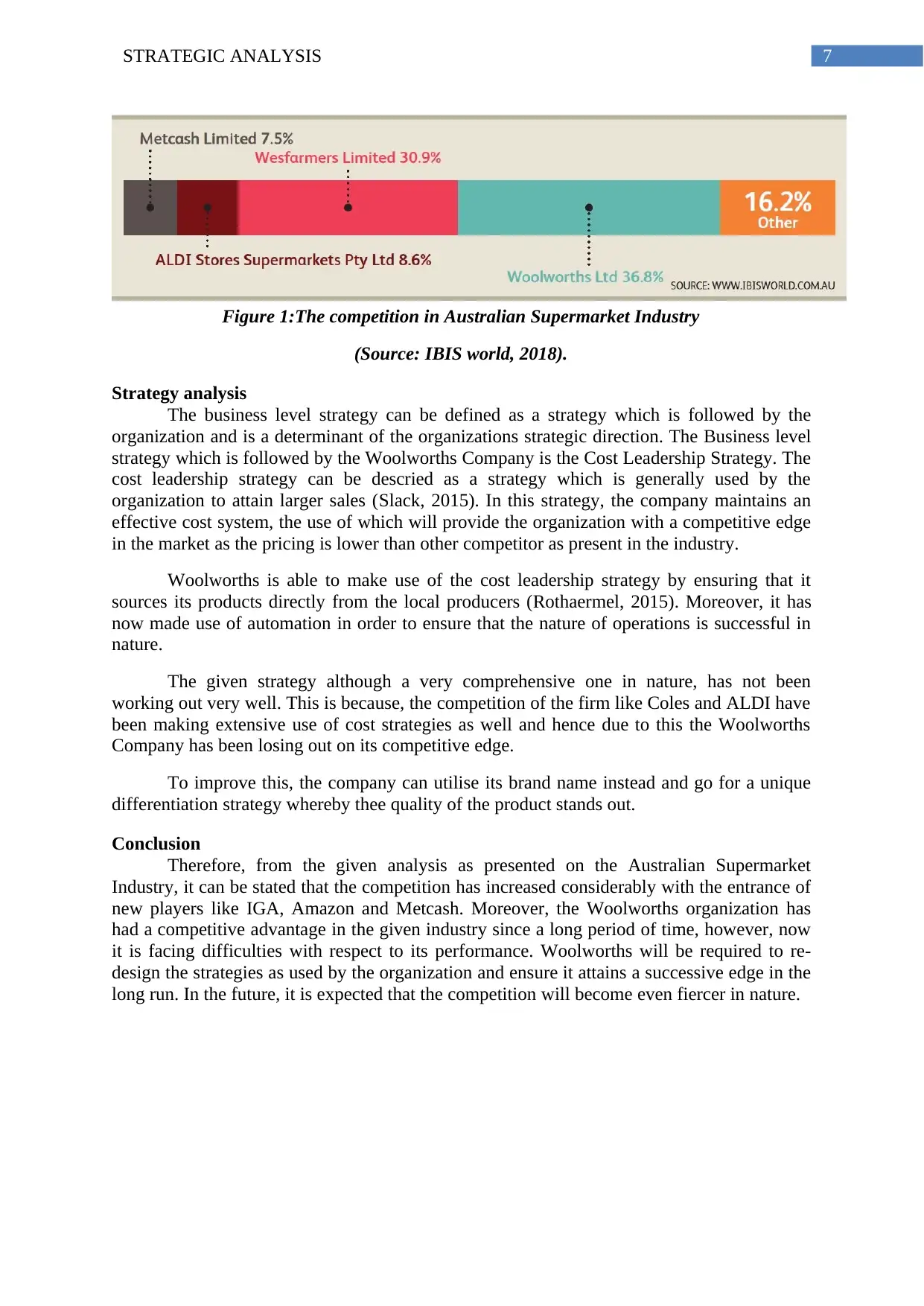
7STRATEGIC ANALYSIS
Figure 1:The competition in Australian Supermarket Industry
(Source: IBIS world, 2018).
Strategy analysis
The business level strategy can be defined as a strategy which is followed by the
organization and is a determinant of the organizations strategic direction. The Business level
strategy which is followed by the Woolworths Company is the Cost Leadership Strategy. The
cost leadership strategy can be descried as a strategy which is generally used by the
organization to attain larger sales (Slack, 2015). In this strategy, the company maintains an
effective cost system, the use of which will provide the organization with a competitive edge
in the market as the pricing is lower than other competitor as present in the industry.
Woolworths is able to make use of the cost leadership strategy by ensuring that it
sources its products directly from the local producers (Rothaermel, 2015). Moreover, it has
now made use of automation in order to ensure that the nature of operations is successful in
nature.
The given strategy although a very comprehensive one in nature, has not been
working out very well. This is because, the competition of the firm like Coles and ALDI have
been making extensive use of cost strategies as well and hence due to this the Woolworths
Company has been losing out on its competitive edge.
To improve this, the company can utilise its brand name instead and go for a unique
differentiation strategy whereby thee quality of the product stands out.
Conclusion
Therefore, from the given analysis as presented on the Australian Supermarket
Industry, it can be stated that the competition has increased considerably with the entrance of
new players like IGA, Amazon and Metcash. Moreover, the Woolworths organization has
had a competitive advantage in the given industry since a long period of time, however, now
it is facing difficulties with respect to its performance. Woolworths will be required to re-
design the strategies as used by the organization and ensure it attains a successive edge in the
long run. In the future, it is expected that the competition will become even fiercer in nature.
Figure 1:The competition in Australian Supermarket Industry
(Source: IBIS world, 2018).
Strategy analysis
The business level strategy can be defined as a strategy which is followed by the
organization and is a determinant of the organizations strategic direction. The Business level
strategy which is followed by the Woolworths Company is the Cost Leadership Strategy. The
cost leadership strategy can be descried as a strategy which is generally used by the
organization to attain larger sales (Slack, 2015). In this strategy, the company maintains an
effective cost system, the use of which will provide the organization with a competitive edge
in the market as the pricing is lower than other competitor as present in the industry.
Woolworths is able to make use of the cost leadership strategy by ensuring that it
sources its products directly from the local producers (Rothaermel, 2015). Moreover, it has
now made use of automation in order to ensure that the nature of operations is successful in
nature.
The given strategy although a very comprehensive one in nature, has not been
working out very well. This is because, the competition of the firm like Coles and ALDI have
been making extensive use of cost strategies as well and hence due to this the Woolworths
Company has been losing out on its competitive edge.
To improve this, the company can utilise its brand name instead and go for a unique
differentiation strategy whereby thee quality of the product stands out.
Conclusion
Therefore, from the given analysis as presented on the Australian Supermarket
Industry, it can be stated that the competition has increased considerably with the entrance of
new players like IGA, Amazon and Metcash. Moreover, the Woolworths organization has
had a competitive advantage in the given industry since a long period of time, however, now
it is facing difficulties with respect to its performance. Woolworths will be required to re-
design the strategies as used by the organization and ensure it attains a successive edge in the
long run. In the future, it is expected that the competition will become even fiercer in nature.
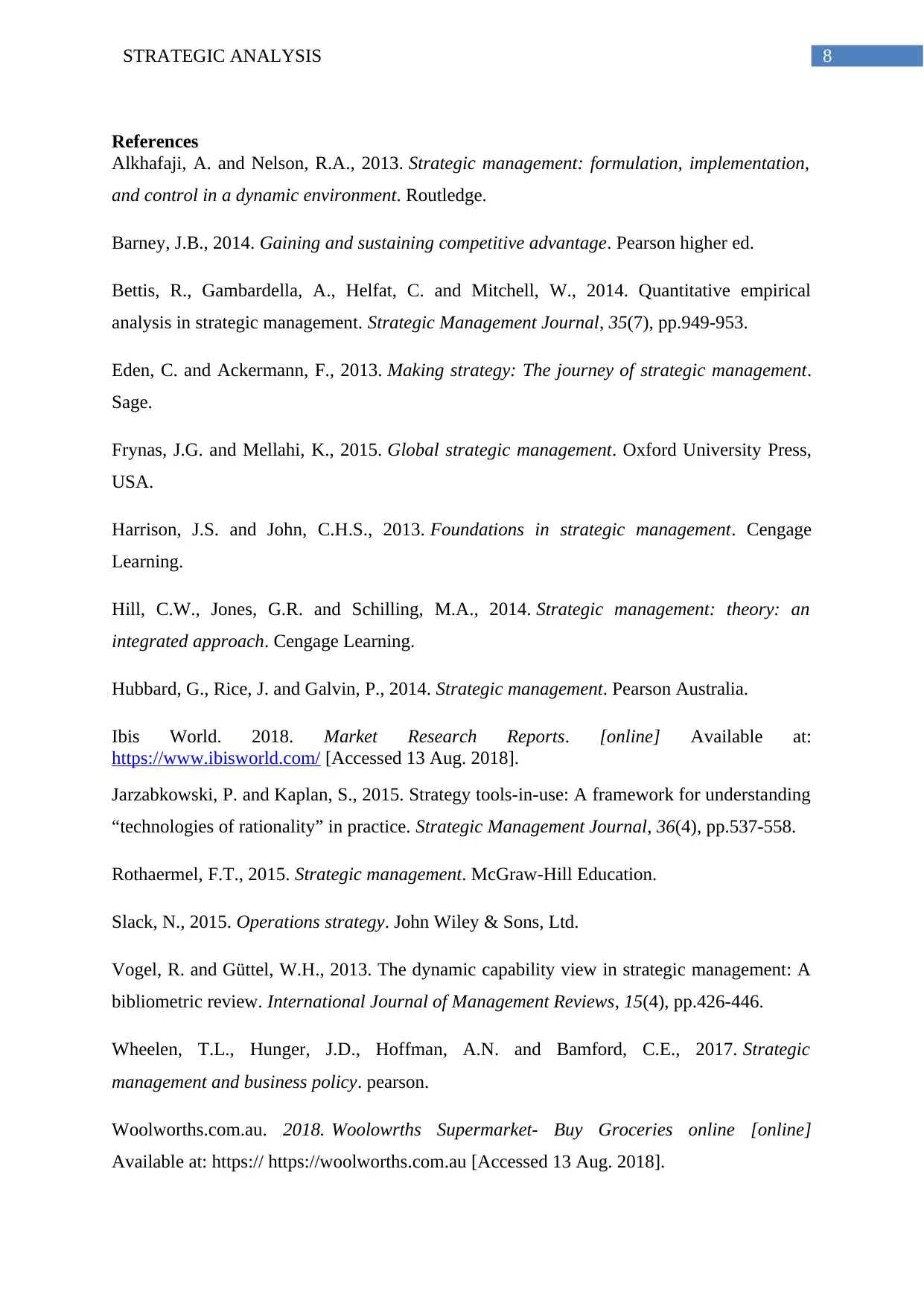
8STRATEGIC ANALYSIS
References
Alkhafaji, A. and Nelson, R.A., 2013. Strategic management: formulation, implementation,
and control in a dynamic environment. Routledge.
Barney, J.B., 2014. Gaining and sustaining competitive advantage. Pearson higher ed.
Bettis, R., Gambardella, A., Helfat, C. and Mitchell, W., 2014. Quantitative empirical
analysis in strategic management. Strategic Management Journal, 35(7), pp.949-953.
Eden, C. and Ackermann, F., 2013. Making strategy: The journey of strategic management.
Sage.
Frynas, J.G. and Mellahi, K., 2015. Global strategic management. Oxford University Press,
USA.
Harrison, J.S. and John, C.H.S., 2013. Foundations in strategic management. Cengage
Learning.
Hill, C.W., Jones, G.R. and Schilling, M.A., 2014. Strategic management: theory: an
integrated approach. Cengage Learning.
Hubbard, G., Rice, J. and Galvin, P., 2014. Strategic management. Pearson Australia.
Ibis World. 2018. Market Research Reports. [online] Available at:
https://www.ibisworld.com/ [Accessed 13 Aug. 2018].
Jarzabkowski, P. and Kaplan, S., 2015. Strategy tools‐in‐use: A framework for understanding
“technologies of rationality” in practice. Strategic Management Journal, 36(4), pp.537-558.
Rothaermel, F.T., 2015. Strategic management. McGraw-Hill Education.
Slack, N., 2015. Operations strategy. John Wiley & Sons, Ltd.
Vogel, R. and Güttel, W.H., 2013. The dynamic capability view in strategic management: A
bibliometric review. International Journal of Management Reviews, 15(4), pp.426-446.
Wheelen, T.L., Hunger, J.D., Hoffman, A.N. and Bamford, C.E., 2017. Strategic
management and business policy. pearson.
Woolworths.com.au. 2018. Woolowrths Supermarket- Buy Groceries online [online]
Available at: https:// https://woolworths.com.au [Accessed 13 Aug. 2018].
References
Alkhafaji, A. and Nelson, R.A., 2013. Strategic management: formulation, implementation,
and control in a dynamic environment. Routledge.
Barney, J.B., 2014. Gaining and sustaining competitive advantage. Pearson higher ed.
Bettis, R., Gambardella, A., Helfat, C. and Mitchell, W., 2014. Quantitative empirical
analysis in strategic management. Strategic Management Journal, 35(7), pp.949-953.
Eden, C. and Ackermann, F., 2013. Making strategy: The journey of strategic management.
Sage.
Frynas, J.G. and Mellahi, K., 2015. Global strategic management. Oxford University Press,
USA.
Harrison, J.S. and John, C.H.S., 2013. Foundations in strategic management. Cengage
Learning.
Hill, C.W., Jones, G.R. and Schilling, M.A., 2014. Strategic management: theory: an
integrated approach. Cengage Learning.
Hubbard, G., Rice, J. and Galvin, P., 2014. Strategic management. Pearson Australia.
Ibis World. 2018. Market Research Reports. [online] Available at:
https://www.ibisworld.com/ [Accessed 13 Aug. 2018].
Jarzabkowski, P. and Kaplan, S., 2015. Strategy tools‐in‐use: A framework for understanding
“technologies of rationality” in practice. Strategic Management Journal, 36(4), pp.537-558.
Rothaermel, F.T., 2015. Strategic management. McGraw-Hill Education.
Slack, N., 2015. Operations strategy. John Wiley & Sons, Ltd.
Vogel, R. and Güttel, W.H., 2013. The dynamic capability view in strategic management: A
bibliometric review. International Journal of Management Reviews, 15(4), pp.426-446.
Wheelen, T.L., Hunger, J.D., Hoffman, A.N. and Bamford, C.E., 2017. Strategic
management and business policy. pearson.
Woolworths.com.au. 2018. Woolowrths Supermarket- Buy Groceries online [online]
Available at: https:// https://woolworths.com.au [Accessed 13 Aug. 2018].
⊘ This is a preview!⊘
Do you want full access?
Subscribe today to unlock all pages.

Trusted by 1+ million students worldwide

9STRATEGIC ANALYSIS
Wright, R.P., Paroutis, S.E. and Blettner, D.P., 2013. How useful are the strategic tools we
teach in business schools?. Journal of Management Studies, 50(1), pp.92-125.
Zott, C. and Amit, R., 2013. The business model: A theoretically anchored robust construct
for strategic analysis. Strategic Organization, 11(4), pp.403-411.
Wright, R.P., Paroutis, S.E. and Blettner, D.P., 2013. How useful are the strategic tools we
teach in business schools?. Journal of Management Studies, 50(1), pp.92-125.
Zott, C. and Amit, R., 2013. The business model: A theoretically anchored robust construct
for strategic analysis. Strategic Organization, 11(4), pp.403-411.
1 out of 10
Related Documents
Your All-in-One AI-Powered Toolkit for Academic Success.
+13062052269
info@desklib.com
Available 24*7 on WhatsApp / Email
![[object Object]](/_next/static/media/star-bottom.7253800d.svg)
Unlock your academic potential
Copyright © 2020–2025 A2Z Services. All Rights Reserved. Developed and managed by ZUCOL.

